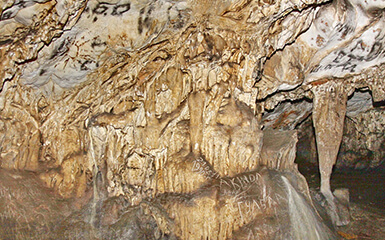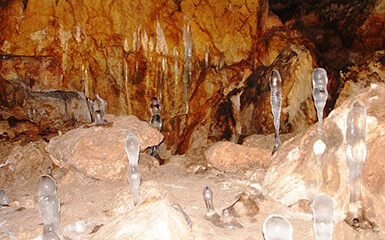The Chil-Ustun cave is located in the Osh region in southwest Kyrgyzstan. It is a karst cave with a length of 400 meters.
Chil-Ustun is located about 23 kilometres west of Osh near the town of Aravan. Geographically, the cave is located on the transition from the Fergana Valley, in which the city of Osh is located, to the Alai Mountains, which characterize the southwest of Kyrgyzstan and the border region to Tajikistan. In the vicinity of the Chil-Ustun cave there are several other caves that are protected as natural monuments together with Chil-Ustun.
The Cave of Chil-Ustun is one of the most beautiful caves in Central Asia. It contains all forms of chemo genic sediments. On the slopes of the first fork of the cave, there are inscriptions in Sanskrit, Arabic and Russian. It is believed that it was written in Sanskrit before the 17th century. Local lamps and other antiques were also found. Ideal for the construction of tourist routes, medical facilities. It is also an interesting cave for historians. Nevertheless, the beautiful stones inside were shattered and looted. The first description of the cave by a European dates back to 1877 by the artist M. Müller, who came to the region as part of a French expedition and also described the Chil-Ustun cave in his notes.
The Chil-Ustun is a karst cave that was created by dissolving limestone. The entrance to the cave is on the southern slope of a 1460 m high mountain above a steep rock at an altitude of 1100 meters. The cave has a total length of 400 meters and consists of three halls of different sizes, which are connected by sometimes very narrow corridors. The largest chamber is 100 meters long, 50 meters wide and 20 meters high. The halls of the Chil-Ustun cave are characterized by numerous stalagmites and stalactites, which probably also gave the cave its name, which is borrowed from Tajik (chil) and Uzbek (ustun) and means 40 piles. The interior of the cave is characterized by very different types of rock and associated colours, which range from light, cream-colored tones to dark brown. The age of the cave is estimated to be 350 million years.
The cave is completely natural; there is no infrastructure for visitors in the area or in the cave itself. Visitors should therefore consult a local guide for a tour.


